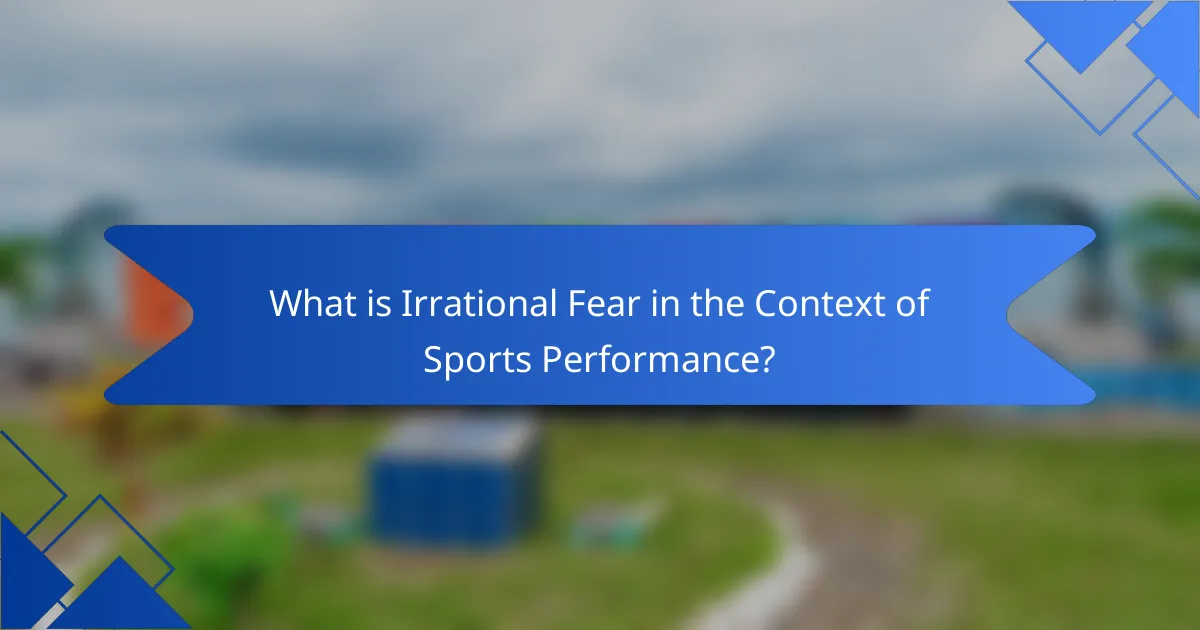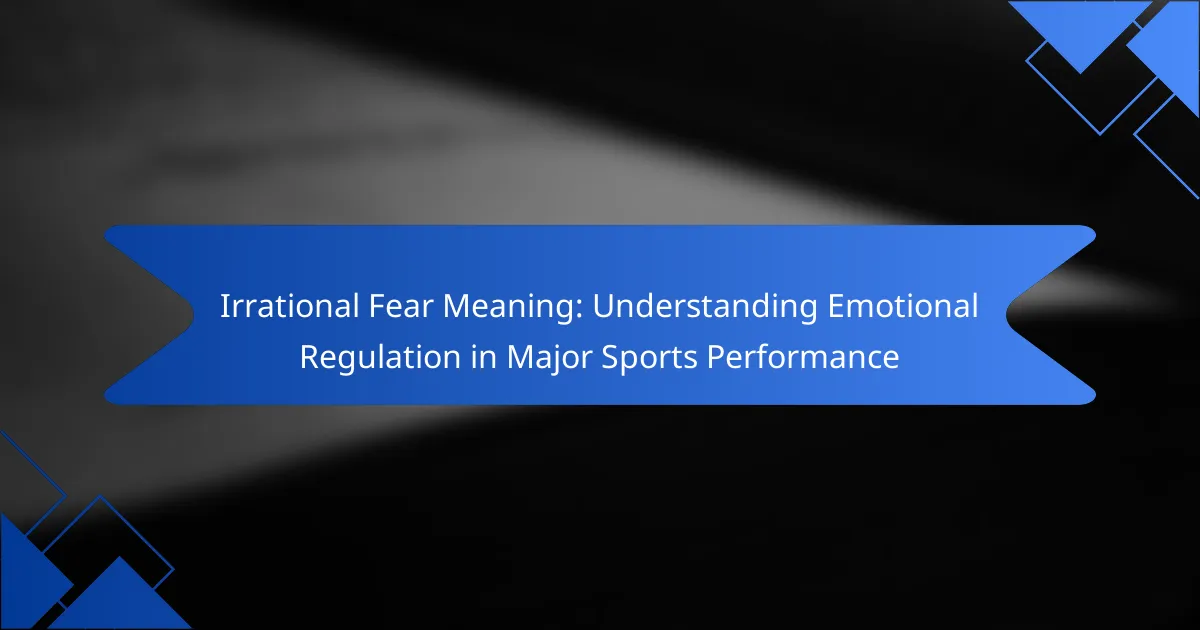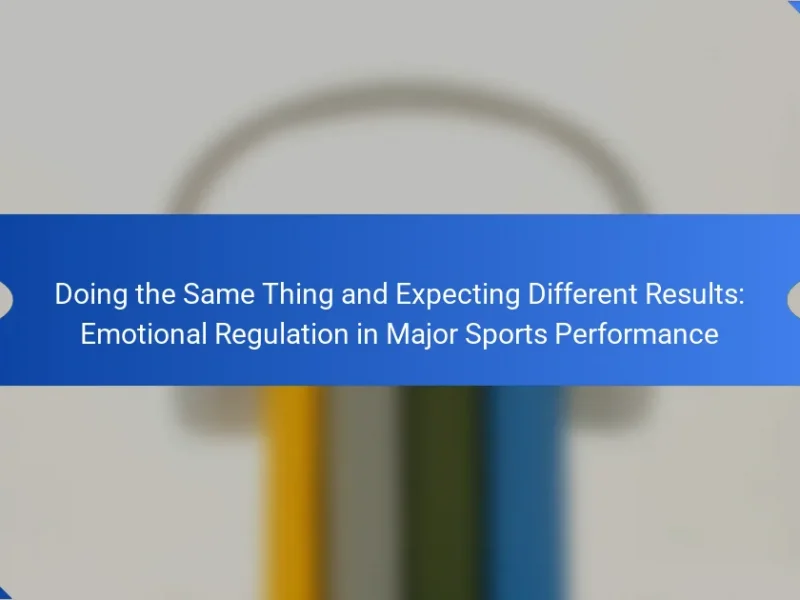Irrational fear in sports performance can significantly hinder an athlete’s ability to compete effectively. This article explores the origins of these fears, emotional regulation strategies like mindfulness and cognitive restructuring, and innovative techniques such as biofeedback. Understanding these aspects is vital for enhancing focus, confidence, and overall performance in high-pressure situations.

What is Irrational Fear in the Context of Sports Performance?
Irrational fear in sports performance refers to anxiety that disrupts an athlete’s ability to perform effectively. This emotional regulation challenge can stem from past experiences, pressure to succeed, or fear of failure. Understanding and addressing these fears is crucial for enhancing performance and achieving mental resilience. Techniques such as visualization, cognitive restructuring, and exposure therapy can help athletes manage irrational fears, leading to improved focus and confidence during competition.
How Does Irrational Fear Impact Athletes’ Performance?
Irrational fear negatively impacts athletes’ performance by hindering focus and increasing anxiety. This emotional regulation issue can lead to decreased confidence and impaired decision-making during critical moments. Studies show that athletes experiencing irrational fear often report lower performance metrics, such as reaction times and accuracy. Techniques like cognitive restructuring can help athletes manage these fears, enhancing their performance in high-pressure situations.
What Are the Psychological Mechanisms Behind Irrational Fear?
Irrational fear often stems from psychological mechanisms such as cognitive distortions and emotional regulation failures. These mechanisms can lead to exaggerated responses to perceived threats, affecting sports performance. For instance, athletes may experience anxiety that hinders their focus and decision-making. Understanding these mechanisms can help in developing strategies to manage fear, enhancing emotional regulation and overall performance.
What Role Does Anxiety Play in Irrational Fear?
Anxiety significantly contributes to irrational fear by amplifying emotional responses. In sports performance, athletes may experience heightened anxiety, leading to exaggerated fears of failure or inadequacy. This can hinder their ability to regulate emotions effectively, resulting in poor performance. Understanding this relationship is crucial for developing strategies to manage anxiety and enhance emotional regulation in high-pressure situations.
How Does Past Experience Influence Irrational Fear?
Past experiences significantly shape irrational fear by creating emotional triggers. These triggers often stem from previous negative outcomes in sports, leading to heightened anxiety during performance. For instance, a past injury may cause an athlete to fear re-injury, impacting their confidence and performance. This emotional regulation is crucial as it influences decision-making and overall mental resilience in high-pressure situations. Understanding these dynamics helps athletes develop coping strategies and improve their performance under stress.

What Are Common Emotional Regulation Strategies Used by Athletes?
Athletes commonly use strategies like mindfulness, cognitive restructuring, and breathing techniques to regulate emotions. These methods help manage irrational fears during competition. Mindfulness enhances focus, cognitive restructuring alters negative thought patterns, and breathing techniques reduce anxiety. Each strategy effectively supports emotional stability and performance.
How Do Breathing Techniques Help Manage Irrational Fear?
Breathing techniques effectively manage irrational fear by promoting emotional regulation. These techniques enhance focus, reduce anxiety, and stabilize physiological responses during high-pressure sports situations. For example, deep breathing can lower heart rate and cortisol levels, enabling athletes to regain control over their emotions. This practice is crucial for maintaining optimal performance and mental clarity. Regular use of breathing techniques can lead to improved resilience against irrational fears, enhancing overall sports performance.
What Is the Role of Visualization in Emotional Regulation?
Visualization plays a crucial role in emotional regulation by helping athletes manage irrational fears during performance. It enables them to mentally rehearse scenarios, reducing anxiety and enhancing focus. This technique allows athletes to visualize success, fostering confidence and a positive mindset. Studies show that visualization can lower stress responses, leading to improved performance outcomes. By integrating this practice, athletes can better control their emotions, ultimately leading to enhanced sports performance.
How Can Mindfulness Practices Aid in Overcoming Irrational Fear?
Mindfulness practices can significantly help athletes manage irrational fear during performance. These techniques enhance emotional regulation, allowing individuals to focus on the present moment and reduce anxiety.
By cultivating awareness, mindfulness helps athletes identify irrational thoughts and challenge them effectively. This process promotes a sense of control and confidence, essential for peak performance in major sports. Research indicates that consistent mindfulness practice can lower stress levels and improve overall mental resilience.
Furthermore, mindfulness techniques, such as meditation and breathing exercises, can be integrated into training routines. This unique attribute of mindfulness not only aids in overcoming irrational fears but also enhances concentration and decision-making during high-pressure situations. As a result, athletes can perform better and achieve their goals with a clearer mindset.

What Unique Emotional Regulation Systems Exist in Major Sports?
Unique emotional regulation systems in major sports include cognitive restructuring, mindfulness techniques, and biofeedback mechanisms. These systems help athletes manage irrational fears that can hinder performance. Cognitive restructuring involves reframing negative thoughts into positive affirmations, enhancing focus. Mindfulness techniques encourage present-moment awareness, reducing anxiety during high-pressure situations. Biofeedback mechanisms provide real-time physiological data, allowing athletes to recognize and control stress responses. Each system uniquely contributes to emotional regulation, fostering resilience and peak performance in competitive environments.
How Do Different Sports Approach Emotional Regulation?
Different sports utilize distinct strategies for emotional regulation, impacting performance. In team sports, such as basketball, players often engage in collective emotional support, fostering a sense of community. Individual sports, like tennis, may require athletes to develop personal coping mechanisms, focusing on self-talk and visualization techniques. Research indicates that emotional regulation significantly influences athletes’ resilience and focus, contributing to performance outcomes. For instance, studies show that athletes with strong emotional regulation skills tend to experience less anxiety and perform better under pressure.
What Strategies Do Team Sports Employ Compared to Individual Sports?
Team sports often utilize strategies that emphasize collaboration and collective emotional regulation, while individual sports focus on personal emotional management. Team sports rely on shared responsibilities, fostering a supportive environment that mitigates irrational fears. In contrast, individual sports demand self-reliance, where athletes must develop personal coping mechanisms to handle performance anxiety.
Team dynamics can create a buffer against irrational fears through communication and mutual encouragement. Individual athletes, however, often face their fears alone, necessitating a deeper understanding of emotional regulation techniques. Both approaches aim for peak performance but differ fundamentally in their execution and reliance on social structures.
The unique attribute of team sports is their ability to harness group psychology, which can significantly enhance emotional resilience. Individual sports require a rare level of self-awareness and discipline to manage fear effectively, showcasing the diverse strategies employed across these domains.
How Do Elite Athletes Utilize Sports Psychologists?
Elite athletes utilize sports psychologists to manage irrational fears, enhancing emotional regulation during performance. These professionals help athletes identify and confront fears, develop coping strategies, and improve focus. Techniques such as visualization and cognitive restructuring are common. Research shows that mental resilience correlates with peak performance, emphasizing the critical role of psychological support in competitive sports.

What Rare Emotional Regulation Techniques Are Emerging in Sports?
Emerging rare emotional regulation techniques in sports focus on innovative strategies to manage irrational fear. Techniques include visualization, mindfulness training, and biofeedback, each tailored to enhance athletes’ performance under pressure. Visualization allows athletes to mentally rehearse success, reducing anxiety. Mindfulness training fosters present-moment awareness, helping athletes detach from fear-based thoughts. Biofeedback utilizes technology to provide real-time physiological data, enabling athletes to regulate their stress responses effectively. These techniques represent unique approaches to emotional regulation, aiming to improve mental resilience in competitive environments.
What Innovative Practices Are Being Adopted by Coaches?
Coaches are adopting innovative practices focused on emotional regulation to address irrational fears in athletes. Techniques include mindfulness training, cognitive behavioral strategies, and visualization exercises. These methods enhance performance by promoting mental resilience and reducing anxiety during competitions. Additionally, technology such as biofeedback is being utilized to monitor emotional states and facilitate real-time adjustments.
How Are Technology and Data Analytics Shaping Emotional Regulation?
Technology and data analytics significantly enhance emotional regulation in major sports performance by providing athletes with real-time feedback and insights. Advanced wearables track physiological responses, helping athletes identify triggers of irrational fear. Data analytics tools analyze performance patterns, enabling tailored mental strategies to manage emotions effectively. As a result, athletes can optimize their focus and resilience during high-pressure situations, leading to improved outcomes. These innovations exemplify how data-driven approaches are reshaping the landscape of emotional regulation in sports.

What Are the Best Practices for Athletes to Manage Irrational Fear?
Athletes can manage irrational fear through techniques like visualization, mindfulness, and cognitive restructuring. These practices enhance emotional regulation, improving performance under pressure. Visualization allows athletes to mentally rehearse success, reducing anxiety. Mindfulness fosters present-moment awareness, helping to detach from fear. Cognitive restructuring challenges negative thoughts, replacing them with positive affirmations. Regular practice of these strategies can significantly diminish irrational fears in sports.
What Common Mistakes Should Athletes Avoid in Emotional Regulation?
Athletes should avoid common mistakes like neglecting self-awareness, failing to seek support, and underestimating the impact of emotions on performance. Recognizing irrational fears can enhance emotional regulation. For example, athletes often misinterpret anxiety as a sign of weakness, leading to performance issues. Addressing these misconceptions is crucial for maintaining focus and confidence during competition.
How Can Coaches Support Athletes in Regulating Their Emotions?
Coaches can support athletes in regulating their emotions by fostering a safe environment for expression and providing coping strategies. Effective communication is essential for understanding athletes’ emotional states. Techniques such as mindfulness and visualization can help athletes manage irrational fears. Regular feedback on performance can also enhance emotional resilience, allowing athletes to focus on process rather than outcomes.
What Expert Insights Can Help Athletes Overcome Irrational Fear?
Athletes can overcome irrational fear by employing emotional regulation techniques. Strategies include cognitive restructuring, mindfulness practices, and visualization exercises. Cognitive restructuring helps athletes identify and challenge negative thoughts. Mindfulness enhances present-moment awareness, reducing anxiety. Visualization allows athletes to mentally rehearse success, fostering confidence. Implementing these techniques can significantly improve performance and mental resilience.


